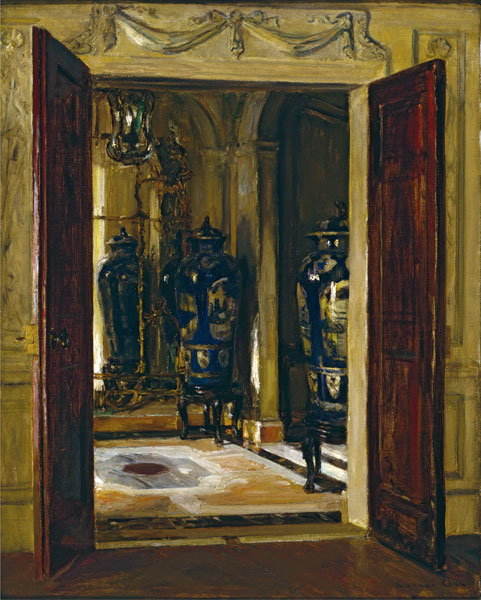
Walter Gay
American, 1856-1937 (active France)
Interior of His Brother’s House in Boston, 1902 ca.
oil on canvas
20 x 24 7/8 in.
SBMA, Anonymous Gift for the Preston Morton Collection
1961.12

Image of and from, A Charmed Couple – The Art and Life of Walter and Matilda Gay
RESEARCH PAPER
Although born a fourth-generation New Englander in Hingham, Massachusetts, Walter Gay chose to live all of his adult life in and around Paris, France. He arrived in the city at the age of twenty as a modestly-trained art student. He could not speak French, but that did not deter him from achieving a prominent place in the Parisian art world. He became one of America’s most successful and admired expatriate artists. For well over fifty years, Walter and his wife, Matilda, were respected members of the artistic and social world of Paris. They never lived in America again.
He was close to his uncle, landscape painter Winckworth Allan Gay. He learned a lot from him about painting as well as about France from listening to him. Both his uncle and William Morris Hunt originally encouraged him to go to Paris to study and paint. While in France, he studied at the studio of Leon Bonnat.
In 1895, he started painting interiors, a long tradition in France, usually by artists commissioned to make accurate renderings of furnishings and architectural elements. Degas and John Singer Sargent did a few paintings of interiors without people. These artists may have influenced Gay, especially Degas, who was one of his favorites.
Gay often altered the contents of a room, moving them until he achieved the right composition. He liked to paint interiors of his friends’ homes and soon was commissioned to do interiors of famous palaces such as Fontainebleau and Versailles.
In 1905, he had a one-man show of 81 paintings and sketches at the Galerie George Petit. It was a great success and resulted in his receiving many new commissions. Another show in 1908 was even more successful. His next show was in 1913 at the 5th Avenue galleries of Gimpel and Wildenstein in New York. Unlike Paris, he was not a success in America.
The Gays traveled for two months every summer. They went to France, Italy, England and America. He painted in all of these locations. Every two or three years they came to America to visit friends and relatives in New York, Boston and Washington. On one of those trips, he painted “Interior of his Brother’s House in Boston” (SBMA painting).
The view is looking into the front hall with two large blue and white Chinese vases on low stands near a large Chippendale-style mirror. Financial difficulties forced the brother, Howard Gay, to sell the house at 170 Beacon Street in 1907. It is now the Friends of Goethe Institute of Boston.
The Gays were avid collectors of 18th century French furniture and tapestries. They had a magnificent collection of paintings and drawings by Holbein, Whistler, Rembrandt, Fragonard, Millet, Rubens, Michelangelo and many others. The major part of their collection was left to the Louvre. Some works were given to the Museum of Fine Arts in Boston.
Walter Gay died at his house, the Chateau de Breau, on July 13, 1937 at the age of 81. His wife, Matilda, died six years later in 1943.
Today, Walter Gay is known almost exclusively for one specific type of painting—the 18th century French interiors that he began painting around 1895. Earlier, he enjoyed success in America painting still life works of flowers, and in Paris painted period genre scenes and peasant life. He even painted an occasional portrait.
However, it was Gay’s paintings of unoccupied interiors that provided him with his greatest success and proved to be his consuming passion for over forty years. The elegance and style that were important parts of Gay’s personal life are mirrored in these paintings. His interiors create a world of bright, sun-filled rooms in which the only concern is for beauty and the fineness of objects. Gay was able to give his paintings personality through a skillful balance of expressive brushwork, attention to details, and a delicate rendering of the changes of light.
Prepared for the Santa Barbara Museum of Art Docent Council by Barbara Ruediger, 2002.
Prepared/edited for SBMA Docent Council website by Stephanie Amon and Lori Mohr, 2012.
BIBLIOGRAPHY
Mead, Katherine Harper. The Preston Morton Collection of American Art. Santa Barbara Museum of Art, Santa Barbara, CA. Pp. 176 and 179.
Rider, William. A Charmed Couple – The Art and Life of Walter and Matilda Gay. Harry N. Abrams, Inc. Publisher, New York. Pp. 84-86.
SBMA CURATORIAL LABELS
Born in Hingham, Massachusetts, Gay spent his entire adult life in the environs of Paris, where he went in 1876 to study with the Realist portrait painter, Léon Bonnat. Formative influences include the art of the Spanish Baroque master Velázquez, which Gay emulated through fluid brushwork and the use of brilliant hues. By 1895, Gay found the niche subject for which he is now celebrated: what amount to portraits of specific interiors such as this one, resplendent with lovingly described French furniture, exotic porcelains, mirrors, and ornate wooden moldings with reflective marble floors. The originality of Gay’s lavish interiors resides in their typically uninhabited state. The artist preferred to signal the personality of the missing inhabitants through scrupulous attention to their aesthetic sensibilities, as expressed through their choice of décor.
- Small-Format American Paintings, 2020
